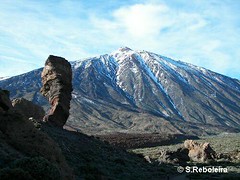The World Heritage Committee today inscribed two natural sites on UNESCO's World Heritage List:
Teide National Park (Spain);
Primeval Beech Forests of the Carpathian (Slovakia, Ukraine)
The Committee also inscribed the Ecosystem and Relict Cultural Landscape of Lopé-Okanda (Gabon) as a mixed - cultural and natural - site.
Four cultural sites were inscribed: the Richtersveld Cultural and Botanical Lanscape (South Africa) as a cultural landscape, and Twyfelfontein or /Ui-//aes (Namibia), the Kaiping Diaolou and Villages (China) and Samarra Archaeological City (Iraq), which was also placed on the List of World Heritage in Danger. It furthermore decided to approve the extension of the natural site of Jungfrau - Aletsch - Bietschhorn, (Switzerland).
Teide National Park (Spain);
Primeval Beech Forests of the Carpathian (Slovakia, Ukraine)
The Committee also inscribed the Ecosystem and Relict Cultural Landscape of Lopé-Okanda (Gabon) as a mixed - cultural and natural - site.
Four cultural sites were inscribed: the Richtersveld Cultural and Botanical Lanscape (South Africa) as a cultural landscape, and Twyfelfontein or /Ui-//aes (Namibia), the Kaiping Diaolou and Villages (China) and Samarra Archaeological City (Iraq), which was also placed on the List of World Heritage in Danger. It furthermore decided to approve the extension of the natural site of Jungfrau - Aletsch - Bietschhorn, (Switzerland).

"Situated on the island of Tenerife, Teide National Park covers 18,990 ha and features the Teide-Pico Viejo stratovolcano that, at 3,718 m, is the highest peak in Spain. Standing 7,500m above the ocean floor, it is regarded as the world's third tallest volcanic structure and is situated in a spectacular environment. The visual impact of the site is all the greater due to atmospheric conditions that create constantly changing textures and tones in the landscape and a ‘sea of clouds' that forms a visually impressive backdrop to the mountain. Teide is of global importance in providing evidence of the geological processes that underpin the evolution of oceanic islands, complementing those of volcanic properties already on the World Heritage List, such as the Hawaii Volcanoes National Park (U.S.A.).
The Primeval Beech Forests of the Carpathian constitute a transnational serial property of ten separate components along a 185 km axis from the Rakhiv Mountains and the Chornohirskyi Range in the Ukraine, west along the Polonynian Ridge, to the Bukovské Vrchy and Vihorlat Mountains in Slovakia. The ten sites represent an outstanding example of undisturbed, complex temperate forests and exhibit the most complete and comprehensive ecological patterns and processes of pure stands of European beech across a variety of environmental conditions. They contain an invaluable genetic reservoir of beech and many species associated with, and dependent on, these forest habitats. They also represent an outstanding example of the re-colonization and development of terrestrial ecosystems and communities after the last ice age, a process which is still ongoing.
The Ecosystem and Relict Cultural Landscape of Lopé-Okanda demonstrates an unusual interface between dense and well conserved tropical rainforest and relict savannah environments with a great diversity of species, including endangered large mammals, and habitats. The site illustrates ecological and biological processes in terms of species and habitat adaptation to post-glacial climatic changes. It contains evidence of the successive passages of different peoples who have left extensive and comparatively well preserved remains of habitation around hilltops, caves and shelters, evidence of iron-working and a remarkable collection of some 1,800 petroglyphs, or rock carvings. (...)
The extension of the natural World Heritage property of Jungfrau - Aletsch - Bietschhorn (first inscribed in 2001), expands the site to the east and west, bringing its surface area up to 82,400 ha., up from 53,900. The site provides an outstanding example of the formation of the High Alps, including the most glaciated part of the mountain range and the largest glacier in Eurasia. It features a wide diversity of ecosystems, including successional stages due particularly to the retreat of glaciers resulting from climate change. The site is of outstanding universal value both for its beauty and for the wealth of information it contains about the formation of mountains and glaciers, as well as ongoing climate change. It is also invaluable in terms of the ecological and biological processes it illustrates, notably through plan succession. Its impressive landscape has played an important role in European art, literature, mountaineering and alpine tourism. "
Text from: Whc.unesco.org
No comments:
Post a Comment